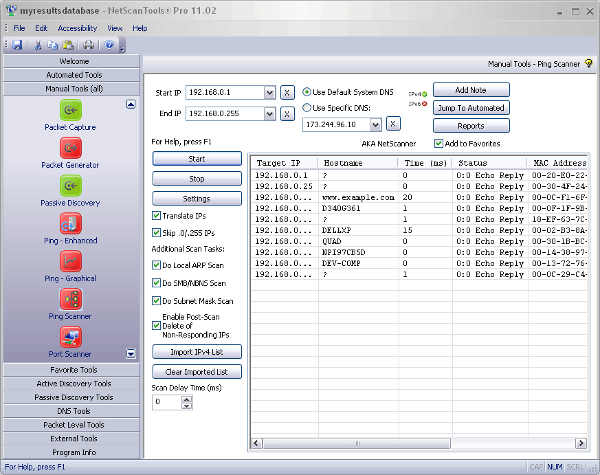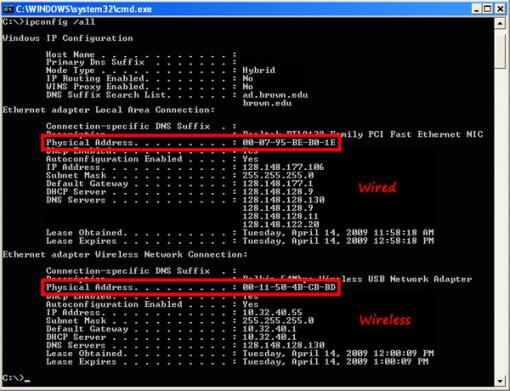Purpose of the Ping Scanner Tool
- How To Scan For Mac Address
- Best Tool To Scan For Mac Addresses On Subnet 10.0.0.0
- Best Tool To Scan For Mac Addresses On Subnets
IP Scanner is a cloud tool that scans your local network and returns a sortable list of the devices it discovers. Devices can be filtered, searched, and exported to CSV. By default, it detects and scans a local subnet, though you can also define a custom IP range. For local network, FastResolver also allows you to get the MAC address of all IP addresses that you scan. FastResolver is a multithreaded application, so it can resolve dozens of addresses within a few seconds. I am reading a Python book and in it there is a script to use scapy, the Python tool/module, to scan a subnet for any hosts that are up and report back their IP and MAC addresses. Use the command arp -A on the server and it will report back the IP address assigned to MAC addresses and whether they are dynamic or static. Use the command arp -A > c: Mac.txt to store the results in a text file for import into other programs.
The purpose of this tool is to locate active IPv4 devices connected to your local network or the internet. NEVER scan a computer you do not own or have the owner's permission to scan.About the Ping Scanner Tool
About the Ping Scanner Tool. The Ping Scanner Tool sends ICMP ping packets to every IP address in any range of IPv4 addresses you specify. It looks for ICMP responses from active devices. This tool operates across any range of IPv4 addresses whether on your subnet or across the internet. During the scan, it displays the current status for each host. After the completion, you can generate detailed scan report in HTML/XML/TEXT/CSV format. Note that you can find MAC address for all systems within your subnet only. For all others, you will see the MAC address of the Gateway or Router. Basic scan or detailed info Discover the devices on your network automatically with the Spiceworks IP Scanner for basic information like OS and MAC Address. Or get detailed hardware and software information on your workstations and servers like CPU, storage, memory, installed software, serial number, and lots more.
How To Scan For Mac Address
The Ping Scanner Tool sends ICMP ping packets to every IP address in any range of IPv4 addresses you specify. It looks for ICMP responses from active devices. This tool operates across any range of IPv4 addresses whether on your subnet or across the internet. It can also ping a list of IPv4 addresses that you need to ping. That list need not be contiguous, it can be random.
Use Ping Scanner to locate active devices and gather other information about those computers. Use this utility in conjunction with the Port Scanner tool for a full accounting of each IP address. This tool is also known as NetScanner (tm) or Ping Sweep.

Related Tool Links
Capabilities and Features
- FAST! Typical time to ping every IP address in the local 254 IP address class C subnet is 3.2 seconds - a faster platform, network and set of targets will give you different results. (Test platform: 3Ghz 2 processor XEON dual core XP SP 3 system with 3.12GB ram and a 100mb wired ethernet interface. Test Conditions: local subnet, ping timeout 2 seconds, ping scan only, no IP/hostname resolution, ARP scan, subnet mask or SMB/CIFS/NetBIOS queries)
- Ping Scanner. Each target IP address is sent ICMP echo request ping packets. Responding device IPs are shown along with the response round-trip-time and the source IP address of the responding ICMP echo reply packet.
- Hostname resolution. Responding IPv4 addresses in the IP range or imported IP list can be optionally resolved to a hostname. This feature is dependent on DNS for accurate results. If you use the 'default System DNS' setting, SMB/CIFS/NetBIOS queries may also obtain the 'windows computer name'.
- Do Local ARP Scan. Following completion of a sweep, NetScanner can make additional ARP requests to responding IPs and add any new MAC address information into the results if MAC addresses were not recorded during the initial scan. This option is only useful for devices on the local subnet since ARP is not routed.
- Do SMB/NBNS Scan - getting a MAC address from SMB/CIFS/NetBIOS Name Server. SMB queries will obtain a MAC address if the target is a Microsoft Windows machine or Linux that responds to SMB queries. If the target responds, you can also get the Remote Machine Name table for viewing in the reports. This feature is optional and will work locally or across the internet if the target is not protected from SMB queries.
- Do Subnet Mask Scan. This option sends a ICMP address mask request and displays any responding information. Some target operating systems will respond, but most Windows versions after Win98 will not respond.
- Reports are available once the sweep is completed showing the scan statistics, report on an individual IP address or a combined results report. The reports are shown in your web browser (searchable, printable, can be saved to disk).
- Import Target IP List from File. This allows you to import a non-contiguous list of IP addresses, ie. random that can be any combination of local or internet IP addresses.
Try the NetScanTools Pro demo free for 30 days

How do you use IP Scanner?
IP Scanner is a cloud tool that scans your local network and returns a sortable list of the devices it discovers. Devices can be filtered, searched, and exported to CSV. By default, it detects and scans a local subnet, though you can also define a custom IP range.
What details does the IP Scanner return?
The IP Scanner lists each device’s hostname, IP address, vendor, OS, MAC address, description, open ports, and if it’s up or down. The kind of data returned depends on the type of device being scanned.
Add agents to your servers and workstations to get more detailed information like CPU, storage, memory, and network adapter details. You can even see the tickets for each device.
How do you set up the IP Scanner?
Best Tool To Scan For Mac Addresses On Subnet 10.0.0.0
IP Scanner uses a small downloadable scan agent to give it access to your local network. To get started click Download to install the scan agent. A wizard will quickly step you through installation.
A browser page will launch and prompt you to scan the detected IP range. You can customize the IP range that will be scanned if the default range doesn’t discover all of your devices.
Best Tool To Scan For Mac Addresses On Subnets
When you’re ready to take your device information collection to the next level, go ahead and click the Agent Download button, then choose Download a Collection Agent. You can get the agent for both Windows and Mac. Then you’ll just copy the agent installer to each device you want to track. Want to save even more time? You can use Group Policy (or whatever 3rd party software distribution service you prefer) to deploy the agent in your network.